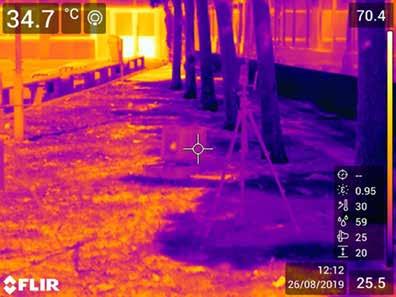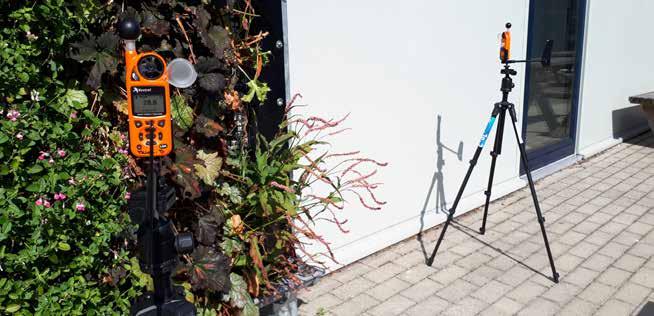
6 minute read
Mitigating heat stress in public open spaces
Landscape practitioners have an important role in increasing thermal comfort in public spaces, but how should it be measured? Readers of Landscape are invited to help develop a new decision-making tool.

As landscape professionals we understand the role of green and blue infrastructure (GBI) as providing a myriad of benefits in our designs and increasingly acknowledge the multiple benefits these have, for example promoting health, exercise, general wellbeing and minimising stress, as well as promoting biodiversity.
Planting trees to sequester CO 2 as mitigation for climate change features in many policies and strategies and the idea of Nature Based Solutions (NbS) is gaining traction. SuDs are universally acknowledged as an effective strategy to mitigate extreme rainfall weather events – but how often is the role of GBI in mitigating local climate impact on people mentioned?
Heat waves are becoming more frequent. The UK Climate Change Risk Assessment 2017 Evidence Report has predicted that heat-related deaths will increase by around 250% by the 2050s, based on the median estimate. The recent IPCC (2018) report, suggesting we have just 12 years to avert catastrophic temperature rise, has heightened awareness of the potential impact of temperature rise and the impacts for human wellbeing (IPCC, 2018). At the same time, concerns are being expressed about the economic impact with predictions that in a warm year in the far future (2081-2100), the heat stress related falls in productivity could mean loss of around €1.9 billion for London alone (Costa et al, 2016)
In this context local authorities are taking this issue very seriously, evidenced by publications such as Rising to the Climate Crisis: A Guide for Local Authorities on Planning for Climate Change (TCPA, 2018) and mitigation measures are increasingly important in strategic plans. This is a key opportunity to promote GBI, adding another persuasive argument to our existing case.

Benny Pyke, of Sioen Industries, setting up the Kestrel 5400 Weather Station. This records altitude (barometric), pressure, wind direction, crosswind, headwind, tailwind, density altitude, dew point temperature, globe temperature, heat stress index, naturally aspirated wet bulb temperature, relative humidity, absolute pressure, temperature, thermal work limit (TWL), wet bulb globe temperature (WBGT), wet bulb temperature (psychrometric), wind chill and wind speed, enabling calculation of PET.
© Sioen Industries NV
Funded by the European INTERREG 2 Seas programme the subtitle of this project is ‘Spatial Adaptation for Heat Resilience in Small and Medium Sized Cities’. It involves partners from Belgium, France and the Netherlands with the University of Greenwich involved on the scientific advisory team. Rather than the familiar Urban Heat Island phenomenon, the focus here is on the microclimate of public open spaces. Small-scale interventions can be used to increase thermal comfort and so encourage use of the spaces – and nearby shops – during heatwaves. The aim is to produce a decision support tool including not only the effectiveness but also the costs and benefits of different GBI interventions to be considered, so that the most appropriate for the situation can be selected.
There are many potential ways of increasing thermal comfort but – as landscape architects will be well aware – designs must also reflect the potential for all forms of extreme weather. What is a cooling breeze in summer can become an unattractive wind tunnel in winter; trees providing welcome shade shed leaves in autumn causing a management headache.
The theory is simple. We can simply stop sunlight reaching people by providing shade using either trees, planted structures such as pergolas, or textile canopies, all of which are most effective with strategically placed seating (I know – bird droppings …). Alternatively, sunlight can be reflected, using light-coloured hard landscape materials or by introducing reflective ‘cool pavements’. Air temperature can be reduced by evaporative cooling if water features, particularly moving ones, are included. The perfect solution – or compromise – will probably involved a combination of all these approaches.
Green walls and façades are increasingly popular despite the capital and maintenance costs. Many claims are made about the benefits in terms of reducing pollution, improving air quality and reducing noise but, although the insulating effects on internal building temperature is well established, and they certainly improve the appearance of buildings, the impact on reducing outdoor temperatures is questionable.

Two Kestrel 5400 Weather Stations, one directly in front of a 6m² southeast facing green wall and the other (the reference measurement) by the aluminum wall of the Sioen plant laboratory.
© Sioen Industries NV
In fact, there is surprisingly little real evidence of the extent to which green infrastructure cools microclimates and even less for blue. The research tends to be location specific, based on recording air temperature and with the majority carried out in warmer climates than we experience; it is difficult to apply the results to different situations. The focus of this project is heat stress, as experienced by people in public open spaces. The way we experience heat is the result of not merely air temperature but a combination of radiation, humidity and wind speed. We feel the heat more on still days with high humidity, as our bodies cannot exploit evaporation as effectively as when there is a breeze. Heat stress is a relatively new concept for northern Europe.
The partners in this project have come together to address the knowledge gap and are actively engaged in measuring the effectiveness of existing GBI, as well as identifying pilot sites for new installations in places where heat stress is an issue. Measuring impact is more complex than it might first appear – which may account for the lack of data – as specific instruments are needed to measure radiation, wind speed and humidity simultaneously to give the physiological equivalent temperature (PET), the standard for determining heat stress. There are also perceptual aspects, as people experience temperature in different ways depending on their metabolism, background and gender; what is a comfortable temperature for one maybe be unpleasant for another. There are a plethora of contributory factors but, as a simple example, greenery and a view of water is generally perceived as cooler than a barren paved area.
To try and take this into account, a questionnaire survey of passers by is being conducted by the project partners at the same time as the PET measurements of existing features in public open spaces to address the data deficient and provide useful information about which are most effective in reducing heat stress. But where then does decision making come in? All the partner organisation have been holding workshops with stakeholders, from elected members to grounds maintenance staff, with the combined purpose of raising awareness of heat stress and finding out what is important to them when they are redesigning or modifying public open spaces.
And the result? You’ve guessed correctly – money! Not merely for purchase and installation, but also for ongoing management. Politicians at all levels want a good news story while at the other end of the spectrum it is about public safety, the cost of collecting fallen leaves and complaints about pigeons that dominate the agenda.
The intention of the ‘Cool Towns’ project is that the decision support tool will be evidence based, reviewing the scientific and grey literature as well as including the direct measurements undertaken by partners. It will include the full spectrum of both the benefits and disbenefits of as many types of intervention as possible. We need your help
1) We need more, different examples to measure and all the results – indeed the whole decision support tool – will be freely available. Assuming we don’t have really unseasonable winter heatwaves, it will be next summer before we are out measuring again, but please do get in touch if you have been involved recently with any urban public open spaces and have made interventions that could be affecting the local microclimate.
2) What would you like the decision support tool to include? Landscape Architects are key decision makers and your input would be very welcome.
Please do get in touch Dr Debbie Bartlett MLI FCIEEM d.bartlett@greenwich.ac.uk
Dr Debbie Bartlett is Principal Lecturer, Environmental Conservation, Pharmaceutical, Chemical and Environmental Sciences Faculty of Engineering and Science, University of Greenwich










